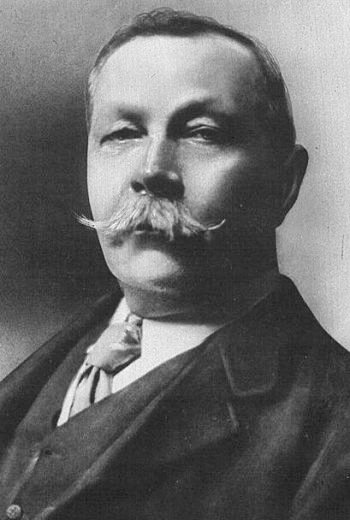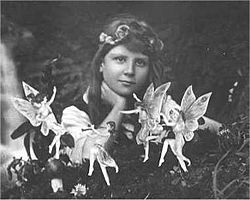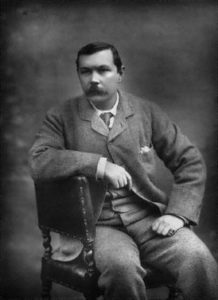
Sir Arthur Conan Doyle, KStj, DL
Happy Birthday Sir Arthur Conan Doyle, you were a giant on whose shoulders many currently stand. A pity you weren’t more like your title character, Sherlock Holmes.
The above paragraph may read as a little inflammatory, perhaps snide as well, but it’s not without reason.
Arthur Ignatius Conan Doyle, born 22 May 1859 in Edinburg, Scotland, was, as some would like to claim, the father of modern crime writing. He wasn’t, actually, as that honour goes to Edgar Allen Poe, but it’s a small quibble. In popular culture, the uncontested, most famous literary detective is, quite obviously, Sherlock Holmes. Holmes was the main character in Conan Doyle’s magnum opus, which consisted of four books and more than 50 short stories.
Of course, we all know exactly who Sherlock Holmes is – with his recent popularisation on the big screen by Robert Downey Jr. – his characteristic logic, astute observation, and keen intellect and his impressive memory (along with his hat and pipe) have become a symbol in our culture for intelligence and well-reasoned inquiry. Conan Doyle crafted, not only a character, but a mythos; unfortunately it wasn’t a self-portrait.
You see, while Conan Doyle was a brilliant author and could rightly be considered a genius in his own right, deductive reasoning and logic weren’t his strong suits, not by a long shot – despite evidence to the contrary. Even though he is most famously known as a classical author of fiction (across multiple genres), it’s true that his focus wasn’t always on writing novels. He was a trained physician, and, for a time, a political activist, a keen footballer and cricketer, and a husband and father. He was knighted by King Edward VII in 1902, was a member of the Venerable Order of St. John, and held the military commission of Deputy Lieutenant.
In addition to all of the above, he was also a leading voice in the Spiritualist movement of the turn of the 20th century. Following the deaths of his first wife in 1902, and the death of his son, Arthur Kingsley, in 1918, as well as other deaths in his immediate circle, Conan Doyle became obsessed with spiritualism and the afterlife.
In fact, he was one of the original members of the renowned, and possibly the first ever paranormal research society: The Ghost Club.
Conan Doyle’s spiritualist exploits are colourful, to say the least. He wrote in support of spiritualism in his Professor Challenger (another of his detective characters) novel The Land of Mist (1926) – this was a companion to his earlier novel The Lost World (1912). That book was essentially his coming out in support of what he believed to be an extremely important, but undervalued part of life. Although his predilection for spiritualism wasn’t exactly a secret prior to this book.
Perhaps his most famous foray into the weird, was his rather loud endorsement of the Cottingley Fairies, which carried the story of Elise Wright and Frances Griffiths around the world, making their fairy photos famous. Unfortunately, the photos were a hoax; and looking back, it’s seems difficult to see how anyone believed the story in the first place, let alone the mind that brought us Sherlock Holmes.
 In his quest for answers, Conan Doyle befriended the one and only Harry Houdini. Oh the conversations those two must have had! Though, Houdini wasn’t a man to be fooled by the trifling ploys of little girls; he was arguably the most successful debunker of charlatan psychics, mediums, and flim-flam artists that there ever was. Despite his reputation as possibly the best magician and escape artist that ever lived, Houdini was an avowed skeptic, and was vocal about the fraud being perpetrated by those in the spiritualist movement. And thus, their brief friendship came to an embarrassing and very public end when they couldn’t reconcile their philosophical differences. Interestingly, Conan Doyle continued to assert that Houdini himself had supernatural or divine powers, most notably in his book The Edge of the Unknown (1930). Not surprisingly though, Houdini vehemently denied this, and even tried to show Conan Doyle how the various tricks were done, but was apparently unsuccessful in convincing the great writer of the truth.
In his quest for answers, Conan Doyle befriended the one and only Harry Houdini. Oh the conversations those two must have had! Though, Houdini wasn’t a man to be fooled by the trifling ploys of little girls; he was arguably the most successful debunker of charlatan psychics, mediums, and flim-flam artists that there ever was. Despite his reputation as possibly the best magician and escape artist that ever lived, Houdini was an avowed skeptic, and was vocal about the fraud being perpetrated by those in the spiritualist movement. And thus, their brief friendship came to an embarrassing and very public end when they couldn’t reconcile their philosophical differences. Interestingly, Conan Doyle continued to assert that Houdini himself had supernatural or divine powers, most notably in his book The Edge of the Unknown (1930). Not surprisingly though, Houdini vehemently denied this, and even tried to show Conan Doyle how the various tricks were done, but was apparently unsuccessful in convincing the great writer of the truth.
Conan Doyle once teamed up with fellow writer and spiritualist William Thomas Stead, and the two of them began promoting the psychic powers of Danish stage magicians and occult authors, Julius and Agnes Zancig. Though, the husband and wife team later confessed that their entire act was fake. He was also responsible for popularising the world famous tale of the ghost ship Mary Celeste, through his short story titled J. Habakuk Jephson’s Statement.
Perhaps the most interesting factoid about Sir Arthur Conan Doyle – one that is relatively unknown in popular culture – is his status as one of the prime suspects in the Piltdown Man hoax.

Arthur Conan Doyle, a portrait by Herbert Rose
If you’re unfamiliar, the Piltdown Man hoax is the name given to the situation that unravelled out of a submission to the Geological Society of London in 1912, wherein amateur archaeologist Charles Dawson presented what he believed was fossilised bone evidence in support of a previously unknown early hominid species. This created quite a stir in the paleoanthropological community, as you might imagine, and the find was heralded as one of the greatest in modern history. That is until, in 1953, it was determined that the bones were a deliberate hoax.
Now, while the case is still officially unsolved, as to who perpetrated the hoax, most believe it was Dawson. Some people claim though, that Dawson didn’t have the expertise needed to pull it off. Some believe that Conan Doyle was better suited for the crime, and with the fact that he lived near Piltdown, and had the relevant and necessary knowledge and skill, he seems a decent candidate…but why?
Well, American historian of science, Richard Milner, claims that, not only did Conan Doyle have the expertise, he had the motive – he wanted to embarrass the scientific community as revenge for debunking his favourite psychic – and he apparently wove cryptic clues to his involvement with the hoax into his novel, The Lost World.
“If you are clever and know your business you can fake a bone as easily as you can a photograph.” – Sir Arthur Conan Doyle, The Lost World
Arthur Conan Doyle certainly isn’t the only name on the suspect list for the Piltdown Man hoax, and there are holes in that particular theory, but his name is still on the list. It would seem, too, that if he did in fact perpetrate the most successful paeleoanthropological hoax ever conceived, then perhaps his mind was more logical than one might think.
Conan Doyle died of a heart attack at the age of 71 on 7 July 1930, he would today be 155 years old. So, Happy Birthday Sir Arthur Conan Doyle, and thank you for all you did to entertain us.
